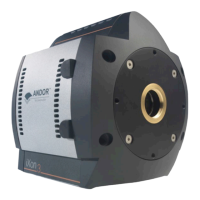Page 23
Features & Functionality
Indeed, multiplicative noise can be thought to contribute directly to the overall shot noise, in that one should multiply
the Shot Noise by the Noise Factor when calculating overall noise. Simply put, multiplicative noise does not in any way
reduce the average signal intensity or reduce the number of photons that are detected, it simply increases the degree of
variation of the signal around the mean value, in addition to the variation that already exists from the shot noise (variation
from pixel to pixel or from frame to frame). This additional variation to the signal intensity is represented pictorially below
in gure 15 as a signal intensity prole.
In the limit of when there is less than 1 electron falling
on a pixel in a single exposure, the EMCCD can be
used in Photon Counting Mode. In this mode a
threshold is set above the ordinary amplier readout
and all events are counted as single photons. In this
mode, with a suitably high gain, a high fraction of
theincidentphotons(>90%)canbecountedwithout
being affected by the Noise Factor effect.
3.1.5 - EM Gain dependence and stability
EM gain is a function of the EM voltage and of the sensor operating temperature. When the user applies gain through the
software, it is the EM voltage in the gain register that is varied. As can be seen from gure 16 below, the dependence
of EM gain on EM voltage is sharp (note the logarithmic scaling). This arises because the signal electrons acquire
energy as they are accelerated through the EM electric eld, and once this eld strength reaches the threshold needed
to overcome the bandgap energy, the
impact ionization rate rises rapidly.
This sharp dependence has meant
that the software control of EM gain
in all EMCCD cameras to date has
been via a non-linear scale, with most
of the amplication occurring within
a relatively small portion at the top of
the overall scale. Thus considerable
ne tuning by the user to determine an
optimal gain setting has been required
and even then the actual gain is
determined only through measurement
of a stable light source, with and
without gain applied.
Figure 16: EM gain vs EM clock voltage
Figure 15: Signal intensity prole

